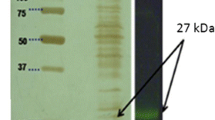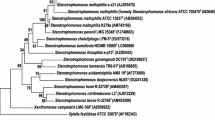Abstract
The gene for a Geobacillus thermoleovorans CCR11 thermostable lipase was recovered by PCR and cloned. Four genetic constructions were designed and successfully expressed in E. coli: (i) the lipase structural gene (lipCCR11) in the PinPoint Xa vector; (ii) the lipase structural gene (lipACCR11) in the pET-28a(+) vector; (iii) the lipase structural gene minus the signal peptide (lipMatCCR11) in the pET-3b vector; and (iv) the lipase structural gene plus its own promoter (lipProCCR11) in the pGEM-T cloning vector. The lipase gene sequence analysis showed an open reading frame of 1,212 nucleotides coding for a mature lipase of 382 residues (40 kDa) plus a 22 residues signal peptide. Expression under T7 and T7lac promoter resulted in a 40- and 36-fold increase in lipolytic activity with respect to the original strain lipase. All recombinant lipases showed an optimal activity at pH 9.0, but variations were found in the temperature for maximum activity and the substrate specificity among them and when compared with the parental strain lipase, especially in the recombinant lipases that contained fusion tags. Therefore, it is important to find the appropriate expression system able to attain a high concentration of the recombinant lipase without compromising the proper folding of the protein.



Similar content being viewed by others
References
Jaeger, K.-E., & Eggert, T. (2002). Lipases for biotechnology. Current Opinion in Biotechnology, 13, 390–397. doi:10.1016/S0958-1669(02)00341-5.
Gupta, R., Gupta, N., & Rathi, P. (2004). Bacterial lipases: An overview of production, purification and biochemical properties. Applied Microbiology and Biotechnology, 64, 763–781. doi:10.1007/s00253-004-1568-8.
Jaeger, K.-E., Ransac, S., Dijkstra, B., Colson, C., Heuvel, M., & Misset, O. (1994). Bacterial lipases. FEMS Microbiology Reviews, 15, 29–63. doi:10.1111/j.1574-6976.1994.tb00121.x.
Sharman, R., Yusuf, C., & Banerjee, U.-C. (2001). Production, purification, characterization, and application of lipases. Biotechnology Advances, 19, 627–662. doi:10.1016/S0734-9750(01)00086-6.
Gupta, R., Rathi, P., Gupta, N., & Bradoo, S. (2003). Lipase assay for conventional and molecular screening: an overview. Biotechnology and Applied Biochemistry, 37, 63–71. doi:10.1042/BA20020059.
Van den Burg, B. (2003). Extremophiles as a source for novel enzymes. Current Opinion in Microbiology, 6, 213–218. doi:10.1016/S1369-5274(03)00060-2.
Kitaura, S., Suzuki, K., & Imamura, S. (2001). Monoacylglycerol lipase from moderately thermophilic Bacillus sp. strain H-257: molecular cloning, sequencing and expression in Escherichia coli of the gene. Journal of Biochemistry, 129, 397–402.
Ruiz, C., Pastor, J., & Diaz, P. (2003). Isolation and characterization of Bacillus sp. BP-6 LipA, a ubiquitous lipase among mesophilic Bacillus species. Letters in Applied Microbiology, 37, 354–359. doi:10.1046/j.1472-765X.2003.01413.x.
Abdel-Fattah, Y., & Gaballa, A. (2008). Identification and over-expression of a thermostable lipase from Geobacillus thermoleovorans Toshki in Escherichia coli. Microbiological Research, 163, 13–20. doi:10.1016/j.micres.2006.02.004.
Drouault, S., Corthier, G., Ehrlich, S., & Renault, P. (2000). Expression of Staphylococcus hyicus lipase in Lactococcus lactis. Applied and Environmental Microbiology, 66, 588–598. doi:10.1128/AEM.66.2.588-598.2000.
Bell, P., Sunna, A., Gibbs, M., Curach, N., Nevalaine, H., & Bergquist, L. (2002). Prospecting for novel lipase genes using PCR. Microbiology, 148, 2283–2291.
Quyen, D., Schmidt-Dannert, C., & Schmid, R. (2003). High-level expression of a lipase from Bacillus thermocatenulatus BTL2 in Pichia pastoris and some properties of the recombinant lipase. Protein Expression and Purification, 28, 102–110. doi:10.1016/S1046-5928(02)00679-4.
Kim, M.-H., Kim, H.-K., Lee, J.-K., Park, S.-Y., & Oh, T.-K. (2000). Thermostable lipase of Bacillus stearothermophilus: high-level production, purification, and calcium-dependent thermostability. Bioscience, Biotechnology, and Biochemistry, 64, 280–286. doi:10.1271/bbb.64.280.
Bell, P., Nevalainen, H., Morgan, H. W., & Bergquist, P. L. (1999). Rapid cloning of thermoalkalophilic lipases from Bacillus spp. using PCR. Biotechnology Letters, 21, 1003–1006. doi:10.1023/A:1005654701905.
Sinchaikul, S., Sookkheo, B., Phutrakul, S., Pan, F.-M., & Chen, S.-T. (2001). Optimization of a thermostable lipase from Bacillus stearothermophilus P1: overexpression, purification, and characterization. Protein Expression and Purification, 22, 388–398. doi:10.1006/prep.2001.1456.
Castro-Ochoa, L. D., Rodríguez-Gómez, C., Valerio-Alfaro, G., & Oliart, R. R. (2005). Screening, purification and characterization of the thermoalkalophilic lipase produced by Bacillus thermoleovorans CCR11. Enzyme and Microbial Technology, 37, 648–654. doi:10.1016/j.enzmictec.2005.06.003.
Ausubel, F., Brent, R. R., Kingstone, M. D., Seidman, S. J., & Struhl, K. (Eds.). (1997). Short protocols in molecular biology. A compendium of methods from current protocols in molecular biology, vol 1 Preparation and analysis of DNA and Enzymatic manipulation of DNA (pp. 2-1–3-50). New York: Wiley.
Kouker, G., & Jaeger, K. (1987). Specific and sensitive plate assay for bacterial lipases. Applied and Environmental Microbiology, 53, 211–213.
Nawani, N., Dosanjh, N., & Kaur, J. (1998). A novel thermostable lipase from a thermophilic Bacillus sp.: characterization and esterification studies. Biotechnology Letters, 20, 997–1000. doi:10.1023/A:1005430215849.
Burnette, W. (1981). “Western Blotting”: Electrophoretic transfer of proteins from sodium dodecyl sulfate-polyacrylamide gels to unmodified nitrocellulose and radiographic detection with antibody and radioiodinated protein A. Analytical Biochemistry, 112, 195–203. doi:10.1016/0003-2697(81)90281-5.
Lowry, O. H., Rosebrough, N. J., Farr, A. L., & Randall, R. J. (1951). Protein measurement with the folin-phenol reagents. The Journal of Biological Chemistry, 193, 265–275.
Prim, N., Sánchez, M., Ruiz, C., Pastor, J., & Diaz, P. (2003). Use of methylumbeliferyl-derivative substrate for lipase activity characterization. Journal of Molecular Catalysis B, Enzymatic, 22, 339–346. doi:10.1016/S1381-1177(03)00048-1.
Schmidt-Dannert, C., Rúa, L., Atomi, H., & Schnmid, R. (1996). Thermoalkalophilic lipase of Bacillus thermocatenulatus. I. Molecular cloning, nucleotide sequence, purification and some properties. Biochimica et Biophysica Acta, 1301, 105–114.
Leow, T., Rahman, R., Basri, M., & Salleh, A. (2004). High level expression of thermostable lipase from Geobacillus sp strain T1. Bioscience, Biotechnology, and Biochemistry, 68, 96–103. doi:10.1271/bbb.68.96.
Adamczak, A., & Porollo, J. M. (2005). Combining prediction of secondary structure and solvent accessibility in proteins. Proteins: Structure, Function, and Bioinformatics, 59, 467–475. doi:10.1002/prot.20441.
Rahman, R., Chin, J., & Salleh, A. (2003). Cloning and expression of a novel lipase gene from Bacillus sphaericus 205y. Molecular Genetics and Genomics, 269, 252–260.
Arpigny, J., & Jaeger, K.-L. (1999). Bacterial lipolytic enzymes: Classification and properties. The Biochemical Journal, 343, 177–183. doi:10.1042/0264-6021:3430177.
Tyndall, J., Sinchaikul, S., Fothergill-Gilmore, T., & Walkinshaw, M. (2002). Crystal structure of a thermostable lipase from Bacillus stearothermophilus P1. Journal of Molecular Biology, 323, 859–869. doi:10.1016/S0022-2836(02)01004-5.
Jaeger, K.-E., Dijkstra, B., & Reetz, M. (1999). Bacterial biocatalysts: molecular biology, three-dimensional structures, and biotechnological applications of lipases. Annual Review of Microbiology, 53, 315–351. doi:10.1146/annurev.micro.53.1.315.
Vieille, C., & Zeikus, G. (2001). Hyperthermopilic enzymes: source, uses, and molecular mechanism for thermostability. Microbiology and Molecular Biology Reviews, 65, 1–43. doi:10.1128/MMBR.65.1.1-43.2001.
Acharya, P., Rajakumara, E., Sankaranarayanana, R., & Rao, N. (2004). Structural basis of selection and thermostability of laboratory evolved Bacillus subtilis lipase. Journal of Molecular Biology, 341, 1271–1281. doi:10.1016/j.jmb.2004.06.059.
Cygler, M., Scrang, J., & Ergan, F. (1992). Advances in structural understanding of lipases. Biotechnology & Genetic Engineering Reviews, 10, 143–184.
Vogt, G., Woell, S., & Argos, P. (1997). Protein thermal stability, hydrogen bonds, and ion pairs. Journal of Molecular Biology, 269, 631–643. doi:10.1006/jmbi.1997.1042.
Overbeeke, P., Govardhan, C., Khalaf, N., Jongejan, J., & Heijnen, J. (2000). Influence of lid conformation on lipase enantioselectivity. Journal of Molecular Catalysis B, Enzymatic, 10, 385–393. doi:10.1016/S1381-1177(99)00110-1.
Acknowledgements
Rodolfo Quintana-Castro (PhD) acknowledges his scholarship from the National Council on Technological Education (Cosnet) and the National Direction of Technological Education (DGEST-SEP). This work was supported by Grant 362.06-P from the National Direction of Technological Education (DGEST-SEP).
Author information
Authors and Affiliations
Corresponding author
Rights and permissions
About this article
Cite this article
Quintana-Castro, R., Díaz, P., Valerio-Alfaro, G. et al. Gene Cloning, Expression, and Characterization of the Geobacillus Thermoleovorans CCR11 Thermoalkaliphilic Lipase. Mol Biotechnol 42, 75–83 (2009). https://doi.org/10.1007/s12033-008-9136-6
Received:
Accepted:
Published:
Issue Date:
DOI: https://doi.org/10.1007/s12033-008-9136-6




